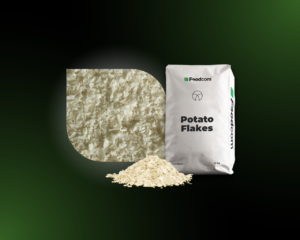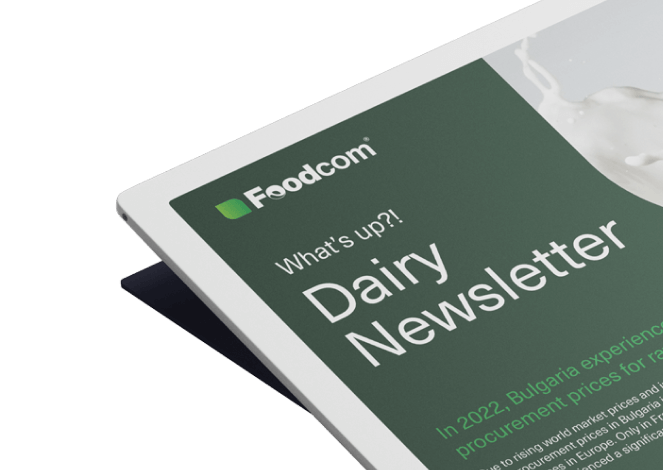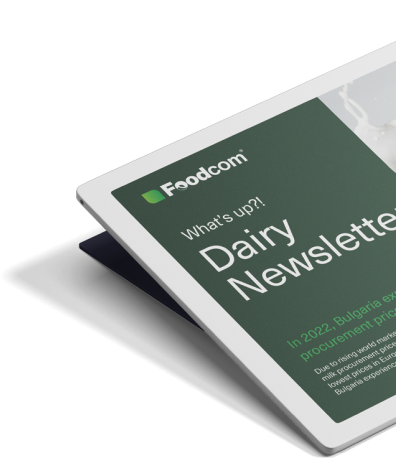- Europe is flooding the market with record harvests – potato prices are plummeting like never before.
- Animal diseases in the EU and Mexico are increasing uncertainty in the agricultural sector.
- Producers are counting their losses, while importers are playing for time and avoiding long-term contracts.
- Global trade is holding its breath – everyone is waiting for Europe to make a move.
- Will 2026 bring a rebound or another wave of declines?
Market dynamics
The year 2025 proved to be an exceptionally difficult one for the European potato sector. A surplus of raw material after a record harvest and large stocks from the previous season led to strong pressure on prices. In March, prices for potatoes for processing in north-western Europe ranged between €175 and €270/MT, representing a 16-20% decline over the week. In the second quarter, average prices in the European Union were already around 29 % lower than a year earlier. In the middle of the year, quotations on the free market fell below EUR 100/MT, and in August local transactions were recorded as low as EUR 15/MT. Such a strong decline has stunted trade, reduced exports and worsened the financial performance of producers and processors. An additional factor weighing down the market were cases of bluetongue disease in several European Union countries, which led to restrictions on breeding and reduced demand for feed, including industrial potatoes.
The global market remained relatively balanced, although local factors continued to influence trade patterns and directions. Stable prices in the United States and Canada contrasted with difficulties in Mexico, where trade and animal transport restrictions were imposed following the detection of screw fly cases in cattle. In Asia and Oceania, quotations remained largely unchanged, with market participants reacting cautiously to signals from Europe.
Regional analysis
Europe
Europe remains the main focus of tension in the global potato market in 2025. A record harvest in the north-western part of the continent has resulted in a significant surplus of raw material, which continues to affect the entire supply chain. The acreage planted for processing increased by around 5.5 % and favourable weather conditions translated into high yields. Already in the first half of the year, oversupply has kept prices at historically low levels, limiting sales on the open market.
In autumn, the situation remains difficult. Some farmers still have stocks of raw material and storage capacity is slowly running out. Processors operate mainly on a contract basis, limiting market flexibility and making it difficult to stabilise prices. Exports remain weaker than in previous seasons and competitive pressures within the European Union are strong. As a result, the European potato sector enters the last quarter of 2025 with persistent oversupply, low margins and uncertainty about developments in the first half of next year.
The agricultural situation is also affected by livestock health factors. An outbreak of bluetongue disease in cattle has been confirmed in Romania and new cases of BTV-3 serotype have been detected in the UK. Restriction zones and veterinary surveillance have been put in place in both countries, which has slowed transport and animal exports. Lower livestock activity has translated into lower demand for industrial potatoes.
Read more: Bluetongue attacks European agribusiness
North America
In 2025, the North American potato market remained relatively stable compared to the situation in Europe. Production in the United States and Canada proceeded without major weather disruptions, and supply was close to the levels of the previous season. Contract prices for processing potatoes remained in a moderate range, with no sharp fluctuations.
The situation was different in Mexico, where new cattle movement regulations were introduced following the detection of screw fly cases. Additional controls and transport restrictions slowed down the animal trade. Livestock farmers bought less feed, which led to turmoil in the local feed sector and translated into lower demand for feed components, including industrial potatoes.
Read more: New cattle regulations in Mexico have unsettled global agribusiness
However, the market reacted to price declines in Europe. Lower raw material quotations across the Atlantic reduced North American export competitiveness, especially in the processed segment. Exporters focused mainly on maintaining their position in Asian markets, where demand remained stable. As a result, the region maintained a balance between production and internal consumption, but price pressures in external markets limited opportunities for margin improvement in the second half of the year.
Oceania
In 2025, the potato market in Oceania remained stable, despite clear price disruptions in Europe. In Australia, potato production proceeded without major weather problems and supply remained close to the previous season’s level. According to mid-year data, yields in the main producing states – South Australia, Victoria and Tasmania – were slightly higher than in 2024, while yields in New Zealand remained at average levels.
Contract prices for processing and fresh market potatoes remained in a moderate range, with no significant fluctuations. The processing sector in Australia reported stable domestic demand and continued demand from retail and foodservice chains. In New Zealand, the market remained balanced, although producers signalled cost pressures related to energy and logistics. European oversupply did not directly affect price levels in the region, but slowed export order growth, particularly in the frozen segment.
Asia
The Asian potato market remains stable in 2025, with production and consumption remaining strong. In China, which accounts for more than a quarter of the world’s production, the harvest went well and yields in the northern provinces were higher than in the previous year. Prices remain within a narrow range, which has favoured liquidity of supply for processing and internal trade. India, the second largest producer in the region, has seen an increase in demand from the food sector, particularly in the second half of the year. Growth in industrial and catering consumption is keeping the market stable despite rising energy and transport costs.
In the rest of Asia, the situation remains balanced. In countries with growing demand for processed products – such as Indonesia, the Philippines and Thailand – active imports persist, especially in the frozen fries segment. Low raw material prices in Europe have affected the pace of contracting supplies, but have not resulted in a decline in purchase volumes. As a result, the continent as a whole maintains a stable supply-demand balance and its markets remain resilient to global price fluctuations.
Middle East and North Africa
In 2025, the potato market in the Middle East and North Africa (MENA) region remains stable, although dependent on the import situation. Production in North African countries, including Egypt and Morocco, has proceeded as planned, with weather conditions favouring good yields. Egypt, a key exporter of potatoes in the region, maintained a high volume of supplies to the European Union, Gulf and sub-Saharan African markets. Local prices remained relatively stable due to strong domestic demand and active exports in the first half of the year.
In the Middle East markets, the situation remains balanced. Importers in Saudi Arabia, the United Arab Emirates and Jordan maintained high purchasing activity with a focus on short-term contracts. The fall in prices of European processed products, especially frozen Chips, has affected trading conditions, but has not led to oversupply. The MENA region maintains a stable market balance, relying on diversified sources of supply and growing consumer demand in the HoReCa sector.
Trends and forecasts
In 2025, the global potato market is in a clear correction phase after two seasons of dynamic growth. Record harvests in Europe, particularly in the north-west, have led to oversupply and a significant drop in prices. Low raw material quotations have reduced trading activity while changing the balance of power in processing. Competition between suppliers has clearly intensified, so market participants are now focusing on maintaining liquidity and reducing excess stocks.
Outside Europe, the situation has remained more balanced. Production in North America, Asia or Oceania has remained stable, maintaining a global balance of supply versus demand. However, low prices in the European Union have become a benchmark for international trade, so that the upside potential in other regions remains limited. Asian importers remain active in their purchasing activities, while increasingly opting for shorter contracts and flexible cooperation models, adapting to the changing price environment.
In the coming months, the market direction will be determined by the pace of sales of European stocks and the health of the processing and catering sectors. Limited cold storage capacity together with rising transport costs are making it difficult to stabilise quotations. At the same time, lower energy prices are supporting processors, so that the supply balance is expected to gradually even out in the first half of 2026.
Increasing animal health problems are taking their toll on the agricultural market. Disease outbreaks in Europe and North America have led to restrictions on livestock breeding and trade, translating into lower demand for feed and industrial raw materials. As a result, global consumption of agricultural products may remain below previous expectations in the near term.
In the longer term, however, the market is moving towards stabilisation. The reduction in plantings in Europe, combined with increasing consumption in Asia and Africa, is expected to gradually rebuild the balance between supply and demand. At the same time, persistent cost differences between regions will continue to shape competitiveness in export markets. The future of the industry will depend on the ability of producers and processors to better plan volumes, optimise logistics and respond more quickly to changes in demand. The global potato sector is thus entering a phase where a key advantage will be gained by those able to combine operational efficiency with a flexible commercial approach.


The year 2025 has turned the potato market upside down. Record harvests in Europe created an oversupply that quickly lowered prices and changed the balance of power. Today, it is apparent that it is Europe that is setting the global benchmark and the rest of the world is reacting to its price movements with caution. Non-EU exporters are holding steady, although many are reducing long-term contracts and opting for shorter sales windows. With such low margins, only quick decisions will maintain profitability. What counts today is efficient planning, stock control and quick response to changes in demand.
Global Foodcom S.A. reports.
Curious about what’s next for potatoes? Discover the latest trends and insights that will shape the final months of 2025. Visit our blog as we regularly update our global reports. Stay up to date with Foodcom S.A.
![Potato market 2025 – global dynamics, regional analysis and key trends [Global Report] Potato market 2025 – global dynamics, regional analysis and key trends [Global Report]](https://foodcom.pl/wp-content/uploads/2021/05/global-report-potatose.png)







